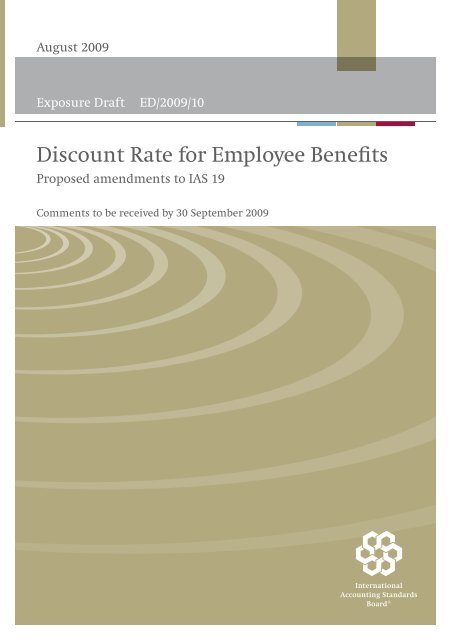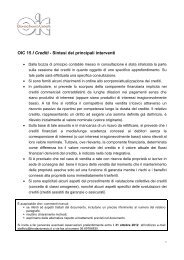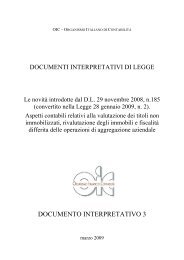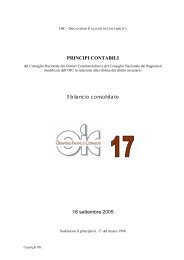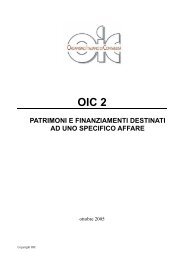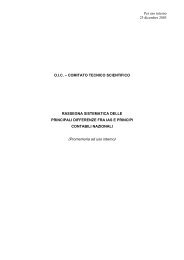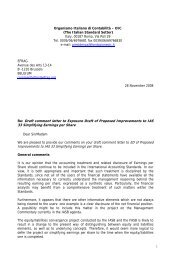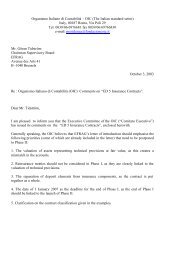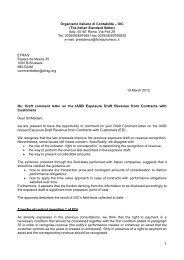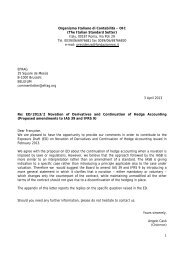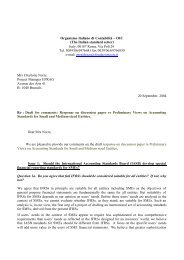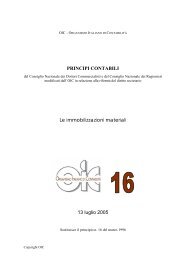ED Discount Rate for Employee Benefits
ED Discount Rate for Employee Benefits
ED Discount Rate for Employee Benefits
- No tags were found...
You also want an ePaper? Increase the reach of your titles
YUMPU automatically turns print PDFs into web optimized ePapers that Google loves.
August 2009Exposure Draft<strong>ED</strong>/2009/10<strong>Discount</strong> <strong>Rate</strong> <strong>for</strong> <strong>Employee</strong> <strong>Benefits</strong>Proposed amendments to IAS 19Comments to be received by 30 September 2009
Exposure DraftDISCOUNT RATEFOR EMPLOYEE BENEFITS(proposed amendments to IAS 19)Comments to be received by 30 September 2009<strong>ED</strong>/2009/10
DISCOUNT RATE FOR EMPLOYEE BENEFITSIntroductionIAS 19 <strong>Employee</strong> <strong>Benefits</strong> requires an entity to determine the rate used to discountemployee benefit obligations with reference to market yields on high qualitycorporate bonds at the end of the reporting period. However, when there is nodeep market in such bonds, IAS 19 requires an entity to use market yields ongovernment bonds instead. The use of these different rates means that entitieswith similar employee benefit obligations can report them at very differentamounts. The significant widening of the spread between yields on corporatebonds and yields on government bonds as a result of the global financial crisis hasconsiderably increased this effect.This exposure draft contains proposals by the International AccountingStandards Board to eliminate the use of different rates by deleting from IAS 19 therequirement to use market yields on government bonds. The Board intends toreview the accounting <strong>for</strong> employee benefits more broadly in due course. Theseproposals are not intended to pre-empt that review.Invitation to commentThe Board invites comments on all aspects of this exposure draft and in particularon the questions set out below. Respondents need not comment on all of thequestions. Comments are most helpful if they:(a)(b)(c)(d)respond to the questions as statedindicate the specific paragraph or paragraphs to which the commentsrelatecontain a clear rationaledescribe any alternatives that the Board should consider.The Board is not requesting comments on matters not addressed in this exposuredraft. Comments should be submitted in writing and must arrive no later than30 September 2009.© Copyright IASCF 4
DISCOUNT RATE FOR EMPLOYEE BENEFITSProposed amendments to IAS 19 <strong>Employee</strong> <strong>Benefits</strong>Paragraph 78 is amended and paragraph 81 is deleted (new text is underlinedand deleted text is struck through). Paragraphs 156A and 159E are added.Post-employment benefits: defined benefit plansRecognition and measurement: present value ofdefined benefit obligations and current service costActuarial assumptions: discount rate78 An entity shall The rate used to discount funded and unfundedpost-employment benefit obligations (both funded and unfunded) shallbe using rates determined by reference to market yields at the end of thereporting period on high quality corporate bonds at the end of thereporting period. In countries where there is no deep market in suchbonds, the market yields (at the end of the reporting period) ongovernment bonds shall be used. The currency and term of the corporatebonds or government bonds shall be An entity shall apply the principlesand approach in paragraphs AG69–AG82 of IAS 39 Financial Instruments:Recognition and Measurement * to estimate such rates by reference to yieldson high quality corporate bonds denominated in the same currency andwhose term is consistent with the currency and estimated term of thepost-employment benefit obligations.81 [Deleted] In some cases, there may be no deep market in bonds with asufficiently long maturity to match the estimated maturity of all thebenefit payments. In such cases, an entity uses current market rates ofthe appropriate term to discount shorter term payments, and estimatesthe discount rate <strong>for</strong> longer maturities by extrapolating current marketrates along the yield curve. The total present value of a defined benefitobligation is unlikely to be particularly sensitive to the discount rateapplied to the portion of benefits that is payable beyond the finalmaturity of the available corporate or government bonds.* In May 2009, the Board published an exposure draft Fair Value Measurement. That exposuredraft contains proposals to replace guidance on fair value in IAS 39. The Board willupdate this reference to be consistent with paragraphs 38–54 of Fair Value Measurementwhen it issues an IFRS resulting from the proposals in that exposure draft.© Copyright IASCF 6
EXPOSURE DRAFT AUGUST 2009Transitional provisions156AAn entity shall:(a)(b)apply the amendments in paragraph 78 and the deletion ofparagraph 81 prospectively from the beginning of the reportingperiod in which it initially applies them.recognise any resulting net change in the defined benefit liability(or asset), including any effect on the limit in paragraph 58(b) as anadjustment to retained earnings at the beginning of that period,and disclose the amount of that adjustment.Effective date159EParagraph 78 was amended and paragraph 81 was deleted by [draft]<strong>Discount</strong> <strong>Rate</strong> <strong>for</strong> <strong>Employee</strong> <strong>Benefits</strong> issued in [date to be inserted afterexposure] 2009. An entity shall apply those amendments <strong>for</strong> annualperiods beginning on or after [date to be inserted after exposure]. Earlierapplication is permitted. If an entity applies the amendments <strong>for</strong> anearlier period, it shall disclose that fact.7 © Copyright IASCF
DISCOUNT RATE FOR EMPLOYEE BENEFITSApproval by the Board of <strong>Discount</strong> <strong>Rate</strong> <strong>for</strong> <strong>Employee</strong><strong>Benefits</strong> (proposed amendments to IAS 19)published in August 2009The exposure draft <strong>Discount</strong> <strong>Rate</strong> <strong>for</strong> <strong>Employee</strong> <strong>Benefits</strong> (proposed amendments toIAS 19) was approved <strong>for</strong> publication by the fifteen members of the InternationalAccounting Standards Board.Sir David TweedieStephen CooperPhilippe DanjouJan EngströmPatrick FinneganRobert P GarnettGilbert GélardAmaro Luiz de Oliveira GomesPrabhakar KalavacherlaJames J LeisenringPatricia McConnellWarren J McGregorJohn T SmithTatsumi YamadaWei-Guo ZhangChairman© Copyright IASCF 8
EXPOSURE DRAFT AUGUST 2009Basis <strong>for</strong> ConclusionsThis Basis <strong>for</strong> Conclusions accompanies, but is not part of, the proposed amendments to IAS 19.BC1BC2This Basis <strong>for</strong> Conclusions summarises the International AccountingStandards Board’s considerations in proposing amendments to IAS 19<strong>Employee</strong> <strong>Benefits</strong>. Individual Board members gave greater weight to somefactors than to others.The Board developed the proposed amendments to deal with an issuethat arises from the requirement in IAS 19 concerning the discount rateused to determine the present value of the defined benefit obligation.The Board was in<strong>for</strong>med, through discussions with its <strong>Employee</strong><strong>Benefits</strong> Working Group, the Pensions and <strong>Employee</strong> <strong>Benefits</strong>Committee of the International Actuarial Association and otherinterested parties, that this requirement means that entities withsimilar employee benefit obligations can report them at very differentamounts. This effect has been much greater as a result of the globalfinancial crisis because of the significant widening of the spreadbetween yields on corporate bonds and yields on government bonds.The Board was also told that it could resolve the issue relatively easilywithout pre-empting the Board’s plans <strong>for</strong> a more fundamental reviewof accounting <strong>for</strong> employee benefits. Accordingly, the Board decided topublish a stand-alone exposure draft dealing with the issue so that itcould finalise any amendments in time <strong>for</strong> early adoption by entitieswith December 2009 year-ends.The proposed amendmentsThe rate used to discount employee benefitsBC3IAS 19 requires an entity to determine the rate used to discount employeebenefits by reference to market yields on high quality corporate bonds.When there is no deep market in such bonds, IAS 19 requires an entity touse market yields on government bonds. As a result, an entity may reporta significantly higher defined benefit obligation in a jurisdiction thatdoes not have a deep market in high quality corporate bonds than itwould in a similar jurisdiction that does have a deep market in suchbonds, even when the underlying obligations are very similar.9 © Copyright IASCF
DISCOUNT RATE FOR EMPLOYEE BENEFITSBC4To eliminate these differences, the Board proposes that the discount rateshould in all cases be based on market yields on high quality corporatebonds at the end of the reporting period. That would have the followingadvantages:(a)(b)It would reduce the range of rates used. This would improvecomparability in financial statements across entities and throughtime <strong>for</strong> the same entity (because markets <strong>for</strong> high qualitycorporate bonds may not remain deep over time). In jurisdictionsthat do not have a deep market in high quality corporate bonds,entities would no longer systematically report liabilities that arehigher than equivalent obligations in other jurisdictions.Entities would no longer need to assess whether a particularcorporate bond market is deep.BC5BC6BC7In some circumstances, an entity will need to estimate the yield on highquality corporate bonds. Such estimates may be more subjective thanestimates of yields on government bonds. Nevertheless, the Boardconcluded that entities could make such estimates with no moresubjectivity than is required <strong>for</strong> many other accounting estimates.Estimating the yield on a bond is essentially the same task as estimatingthe fair value of the bond. Accordingly, the Board proposes to replaceparagraph 81 of IAS 19 with a cross-reference to IAS 39 FinancialInstruments: Recognition and Measurement as a means of providingappropriate guidance <strong>for</strong> estimating bond yields. The Board expects toreplace that guidance in 2010 when it issues an IFRS resulting from theproposals in the exposure draft Fair Value Measurement published in May2009.The Board intends to review the accounting <strong>for</strong> employee benefits morebroadly in due course. These proposals are not intended to pre-empt thatreview. The Board has not yet considered whether the measurement ofemployee benefit obligations could be improved more generally and, inparticular, the Board has not yet considered whether the yield on highquality corporate bonds is the most appropriate discount rate <strong>for</strong>post-employment benefit obligations. The Board’s objective in publishingthese proposals is only to introduce more consistency into the existingrequirements.© Copyright IASCF 10
EXPOSURE DRAFT AUGUST 2009Transition and effective dateBC8IAS 8 Accounting Policies, Changes in Accounting Estimates and Errors requiresentities to apply changes in accounting policy retrospectively, unlesseither it is impracticable to do so or the change in accounting policyresults from another IFRS that contains specific transitional provisions.In determining whether to propose specific transitional arrangements<strong>for</strong> the proposals in the exposure draft, the Board noted the following:(a) when an entity applies the ‘corridor approach’ in IAS 19,retrospective application of the proposed amendments wouldrequire an entity to determine the defined benefit obligation <strong>for</strong>each year since the inception of the plan in order to determine thenet cumulative unrecognised gains or losses at the date ofapplication. In the Board’s view, this process would be costly andthe resulting in<strong>for</strong>mation would not benefit users.(b)in jurisdictions in which there is no observable market price <strong>for</strong>high quality corporate bonds, or few or no observable inputs,retrospective application may be impracticable because it mayrequire judgments that could be affected by hindsight.BC9BC10BC11Accordingly, the Board proposes that an entity should apply the proposedamendments prospectively from the beginning of the period in which itinitially applies them.The Board considered whether the change in the defined benefit liability(or asset) that arises from application of the proposed amendmentsshould be recognised as an actuarial gain or loss in the period of initialapplication. Those actuarial gains and losses would be recognised inaccordance with the entity’s accounting policy <strong>for</strong> actuarial gains andlosses. Other changes in discount rate are accounted <strong>for</strong> in this way.However, the proposed amendments would result in a change inaccounting policy <strong>for</strong> some entities. Recognising the effect of suchchange as an actuarial gain or loss would combine in<strong>for</strong>mation aboutgains and losses associated with changes in circumstances with thoseresulting from the change in accounting policy. Accordingly, theexposure draft proposes that any effect arising from the change should berecognised directly in retained earnings, in the same way as otherchanges in accounting policy.The Board will set the effective date <strong>for</strong> the proposed requirements whenit approves the amendments. The Board normally sets an effective dateof between six and eighteen months after issuing amendments.11 © Copyright IASCF
DISCOUNT RATE FOR EMPLOYEE BENEFITSBC12The Board also expects to publish late this year an exposure draft ofamendments to IAS 19 that addresses presentation of defined benefitpost-employment benefits and disclosures about them. The Boardconsidered the implications <strong>for</strong> entities of its decision to publish twoexposure drafts on amendments to IAS 19 within a relatively short period.However, as explained in paragraph BC2, the Board believes that theproposed amendments in this exposure draft are urgent and that someentities may wish to apply them in their December 2009 financialstatements. Accordingly, the Board intends to set the same effective date<strong>for</strong> the amendments resulting from both exposure drafts, but permitearly adoption of these proposed amendments.Exposure periodBC13The Board intends to finalise any amendments resulting from thisexposure draft as soon as possible in order to make them available <strong>for</strong>early adoption by entities with December 2009 year-ends. Accordingly,the Board decided that the comment period would end on 30 September2009. The Board believes that an exposure period shorter than the Board’snormal 120 days is justified because the matter is urgent, the proposedamendments are straight<strong>for</strong>ward and the document is short. In addition,the Board believes from discussions with the Pensions and <strong>Employee</strong><strong>Benefits</strong> Committee of the International Actuarial Association, theBoard’s <strong>Employee</strong> <strong>Benefits</strong> Working Group and other interested partiesthat the proposed amendments would provide a worthwhile, necessaryand urgent improvement to IAS 19.© Copyright IASCF 12


